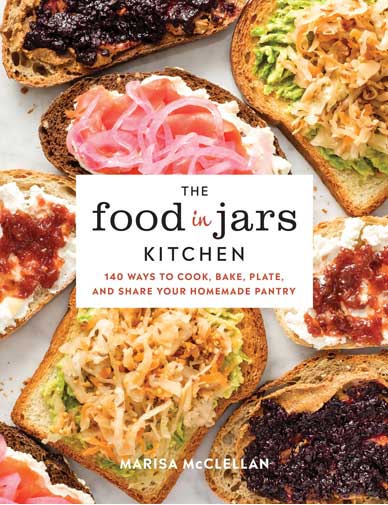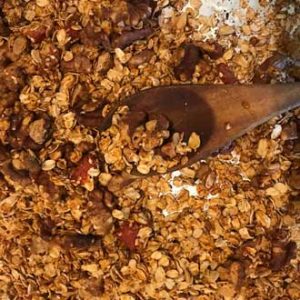 I hate food waste, and so does Food in Jars blogger and cookbook author Marisa McClellan. You may know Marisa as your go-to guru for canning, pickling and preserving, but with her new book Food in Jars Kitchen, she takes the food out of the jar and puts it to work. “My goal with this book is to find ways to use what you make, to give people ways to use up their preserves every hour of the day — breakfast items, snacks, salads you can packed for work, pastas, cocktails, dessert.”
I hate food waste, and so does Food in Jars blogger and cookbook author Marisa McClellan. You may know Marisa as your go-to guru for canning, pickling and preserving, but with her new book Food in Jars Kitchen, she takes the food out of the jar and puts it to work. “My goal with this book is to find ways to use what you make, to give people ways to use up their preserves every hour of the day — breakfast items, snacks, salads you can packed for work, pastas, cocktails, dessert.”
Marisa doesn’t just write about it, she lives it. The day before heading out for her book tour, she’s busy cleaning out her fridge. “I have two open jars of salsa, a pepper that needs to be used, beans I cooked over the weekend, and a bundle of Swiss chard,” she says. ‘I know if don’t use these things up before I leave, they will wither.” Instead, they’re destined to meet each other in the stew pot where they will become chili to feed her husband while she’s away. This is a girl after my own heart.
I’m not sure where I got my passion for preserving food. I didn’t grow up with it. Neither did Marisa. “We did a little bit of jam-making, “ she recalls. She enjoyed eating the preserves but making them wasn’t an especially ah-hah experience for her. It wasn’t until years later, after an ambitious afternoon of blueberry picking Marisa made jam again. At the time, she’d been blogging at SlashFood, AOL’s now-defunct food website. “Before I started blogging, I didn’t even think about jam. Canning was simply a hobby.” Food in Jars was a way to stay part of the food blogging community. “I was no more than a half-step ahead of the questions I got.”

Self-taught rather than professionally trained, “I did a ton of reading, took online courses, read FDA guidelines for commercial production,” and did a lot of pickling, preserving and canning. “Now I’m two or three steps ahead of people’s questions — a much more comfortable thing.”
That comfort comes through when we speak and it comes through in her hands-on classes. “That’s the thing I hear most from people — they’re always so taken about how relaxed I am with the canning process,” she says. “There doesn’t need to be tension.” But when there is, Marisa talks you down, from blue garlic in the pickles to black scum on jars.
Looking to up your canning game? “Downsize,” she says. “You have a lot more control when you have a smaller batch. You can be more aware of a finished texture of a pickle, the set point of a jam. You become more aware of every step of the process.” In other words, it’s about practicing mindfulness, with its myriad benefits, including artisanal, small batch product. Instead of a dozen jars of something it’ll take you ages to get through, think “three small jars of strawberry balsamic jam, three small jars of delicious black cherry preserves.”
Delicious has to part of the equation. “That’s the #1 criteria,” Marisa says. “It has to taste good, be satisfying and be easy enough to make. I’m writing for home cooks. I don’t want to do something wacky or esoteric.” Her idea for jam-glazed rice cakes sounded terrific, but failed recipe testing and failed to earn its place in Food in Jars Kitchen. Sauerkraut chocolate cake, on the other hand, made the cut.
 Sounds weird, but it has historic precedence. Back in the 1950s and ‘60s, “Schools and cafeterias got a lot of government surplus sauerkraut. They had to figure out what to do with it.” Those of you who’ve canned a lot of cabbage may find yourself in a similar situation. Much like the beets in my chocolate beet cake recipe, the sauerkraut is barely there, but “it makes the cake really tender and light,” says Marisa. “It brings a tanginess like sour cream does. It’s delicious, it’s fermented, it’s chocolate. Hard to go wrong with that.” It might even get you thinking about canning some kraut
Sounds weird, but it has historic precedence. Back in the 1950s and ‘60s, “Schools and cafeterias got a lot of government surplus sauerkraut. They had to figure out what to do with it.” Those of you who’ve canned a lot of cabbage may find yourself in a similar situation. Much like the beets in my chocolate beet cake recipe, the sauerkraut is barely there, but “it makes the cake really tender and light,” says Marisa. “It brings a tanginess like sour cream does. It’s delicious, it’s fermented, it’s chocolate. Hard to go wrong with that.” It might even get you thinking about canning some kraut
“Canning is a culinary experience that endures,” says Marisa. “When you cook a meal, you get 20 minutes of pleasure and it’s done. And you have to do it again. When you can something, you get to re-experience the pleasure of that day picked with friends, canned with family member, you get to relieve that experience over and over and over again.”
Turning surplus produce into artisanal product may still be passed down from generation to generation, a labor of love and necessity friends and neighbors do together. For the rest of us, there’s Food in Jars.

Tomato Jam and Smoked Paprika Granola
Ingredients
Smoked Paprika Granola:
- ¾ cup/180 ml Tomato Jam see recipe at bottom
- ¼ cup/60 ml extra-virgin olive oil
- 1 tablespoon smoked paprika
- 2 cups/200 g rolled oats
- 1 cup/120 g raw chopped almonds
- ½ cup/80 g mixed sesame and poppy seeds
- 1 teaspoon flaky finishing salt
- ½ cup/90 g dried cherry tomatoes
Tomato Jam
- 5 pounds/2.3 kg tomatoes chopped
- 3½ cups/700 g granulated sugar
- ½ cup/120 ml bottled lime juice
- 1 tablespoon grated fresh ginger
- 1 tablespoon red pepper flakes use less if you don’t like a lot of heat
- 2 teaspoons fine sea salt
- 1 teaspoon ground cinnamon
- ½ teaspoon ground cloves
Instructions
Smoked Paprika Granola:
- Preheat the oven to 325°F/163°C and line a rimmed baking sheet with parchment paper.
- Combine the jam and oil in a measuring cup. If the jam is very chunky, give it a quick purée with an immersion blender. If it is very stiff and hard to mix, microwave the mixture in 5-second increments on HIGH until soft enough to stir and spread. Stir the smoked paprika into the jam mixture.
- In a large bowl, combine the oats, almonds, and seeds. Pour in the jam mixture. Stir until all the ingredients are well integrated.
- Spread the mixture on the prepared baking sheet. Bake for 20 to 25 minutes, stirring the granola at least twice during baking. The granola is done when it has taken on a deep golden color, smells fragrant, and is no longer visibly moist, though it won’t look completely dry until it is fully cool.
- Remove the granola from the oven and sprinkle on the salt while the granola is still hot. Stir in the dried tomatoes and let it cool completely on the baking sheet. Once it is entirely cool, funnel it into an airtight jar or food storage container. It will keep in the pantry for up to 2 weeks. For longer-term storage, keep the finished granola in the refrigerator.
Tomato Jam
- Prepare a boiling water bath and 3 pint-size/500 ml jars.
- Combine the tomatoes, sugar, lime juice, ginger, red pepper flakes, salt, cinnamon, and cloves in a large, nonreactive pot. Bring to boil over high heat. Once the mixture has reached a hard boil, lower the temperature to medium high.
- Stirring regularly, cook the jam at a low boil until it reduces to a sticky, jammy mess. This will take between 1 and 1½ hours, depending on the width of your pot, the amount of water content in the tomatoes, and the temperature at which you are cooking. Watch closely during the final 15 minutes of cooking, because at this point, the jam scorches easily. When the jam is shiny and thick, and doesn’t seem to have any watery liquid separating out, remove the pot from the heat.
- Ladle the jam into the prepared jars, leaving ½ inch/1.25 cm of headspace. Wipe the rims, apply the lids and rings, and process the filled jars in a boiling water bath for 20 minutes.
- When the time is up, remove the jars and set them on a folded kitchen towel to cool. When the jars have cooled enough that you can comfortably handle them, check the seals. Sealed jars can be stored at room temperature for up to 1 year. Any unsealed jars should be refrigerated and used promptly.


Leave a Reply